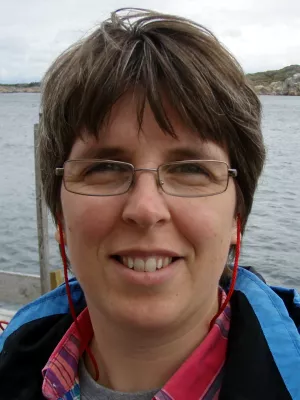
Helena Alexanderson
Professor

Early Holocene dune field development in Dalarna, central Sweden : A geomorphological and geophysical case study
Författare
Summary, in English
Bonäsheden, Sweden's largest continuous dune field, situated in the county of Dalarna, central Sweden, has been investigated using LiDAR (light detection and ranging) remote sensing, ground penetrating radar as well as by field observations and luminescence dating. The use of LiDAR in conjunction with geographic information system (GIS) software proved to be efficient in mapping the inactive dune field and classifying the dune morphology, especially when slope raster images were used. The dunes have formed mostly by winds from the northwest (NW) and are of a transverse type. Still other dune types, such as parabolic dunes, and transverse dunes with a deviating orientation are present. Also, there seems to be different generations of dunes, suggesting a complex palaeowind environment with a change from predominantly north-westerly winds to more westerly winds. Luminescence dating finally allows us to have an absolute chronology of the development of the Bonäsheden dune field, revealing formation of the dune field closely following the de-glaciation of this part of Sweden (c. 10.5ka). The well preserved transverse shape of the majority of the dunes suggests rapid stabilization by vegetation, although sand drift still seems to have been active on a noticeable scale for at least 1500years and also, occasionally and patchy, as coversand deposition during the Late Holocene. A simple model is proposed for the dune field development of Bonäsheden based on our findings. This model is a useful addition since the majority of present day dune field models focus on the formation of parabolic dunes or large unvegetated dune fields. Our results suggest that most models cannot adequately simulate the formation of such small dune fields as that of Bonäsheden, with apparently rapidly fixated transverse dunes in a previously glaciated, now vegetated area.
Avdelning/ar
- Kvartärgeologi
Publiceringsår
2017-09-30
Språk
Engelska
Sidor
1847-1859
Publikation/Tidskrift/Serie
Earth Surface Processes and Landforms
Volym
42
Issue
12
Dokumenttyp
Artikel i tidskrift
Förlag
John Wiley & Sons Inc.
Ämne
- Geology
Nyckelord
- Aeolian inland dunes
- GPR
- Holocene
- LiDAR remote sensing
- Sweden
Status
Published
Projekt
- Aeolian activity in Sweden: an unexplored environmental archive
- Aeolian records
- Aeolian Dunes of Central Scandinavia
ISBN/ISSN/Övrigt
- ISSN: 0197-9337

